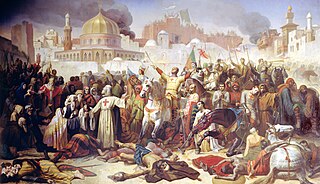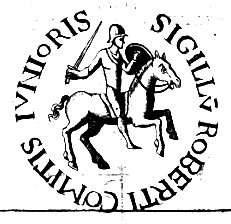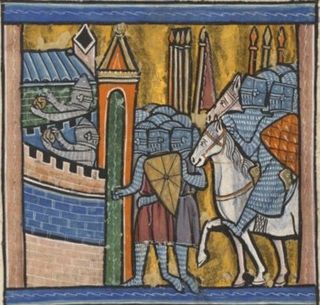
Adhemarde Monteil was one of the principal figures of the First Crusade and was bishop of Puy-en-Velay from before 1087. He was the chosen representative of Pope Urban II for the expedition to the Holy Land. Remembered for his martial prowess, he led knights and men into battle and fought beside them, particularly at the Battle of Dorylaeum and Siege of Antioch. Adhemar is said to have carried the Holy Lance in the Crusaders’ desperate breakout at Antioch on 28 June 1098, in which superior Islamic forces under the atabeg Kerbogha were routed, securing the city for the Crusaders. He died in 1098 due to illness.
The 1090s was a decade of the Julian Calendar which began on January 1, 1090, and ended on December 31, 1099.

Year 1099 (MXCIX) was a common year starting on Saturday of the Julian calendar.

Year 1098 (MXCVIII) was a common year starting on Friday of the Julian calendar.

The First Crusade (1096–1099) was the first of a series of religious wars, or Crusades, initiated, supported and at times directed by the Latin Church in the Middle Ages. The objective was the recovery of the Holy Land from Islamic rule. While Jerusalem had been under Muslim rule for hundreds of years, by the 11th century the Seljuk takeover of the region threatened local Christian populations, pilgrimages from the West, and the Byzantine Empire itself. The earliest initiative for the First Crusade began in 1095 when Byzantine emperor Alexios I Komnenos requested military support from the Council of Piacenza in the empire's conflict with the Seljuk-led Turks. This was followed later in the year by the Council of Clermont, during which Pope Urban II supported the Byzantine request for military assistance and also urged faithful Christians to undertake an armed pilgrimage to Jerusalem.

Godfrey of Bouillon was a preeminent leader of the First Crusade, and the first ruler of the Kingdom of Jerusalem from 1099 to 1100. Although initially reluctant to take the title of king, he agreed to rule as prince (princeps) under the title Advocatus Sancti Sepulchri, or Advocate of the Holy Sepulchre.

Raymond of Saint-Gilles, also called Raymond IV of Toulouse or Raymond I of Tripoli, was the count of Toulouse, duke of Narbonne, and margrave of Provence from 1094, and one of the leaders of the First Crusade from 1096 to 1099. He spent the last five years of his life establishing the County of Tripoli in the Near East.

The Holy Lance, also known as the Spear of Longinus, the Spear of Destiny, or the Holy Spear, is alleged to be the lance that pierced the side of Jesus as he hung on the cross during his crucifixion. As with other instruments of the Passion, the lance is only briefly mentioned in the Christian Bible, but later became the subject of extrabiblical (Apocrypha) traditions in the medieval church. Relics purported to be the lance began to appear as early as the 6th century, originally in Jerusalem. By the Late Middle Ages, relics identified as the spearhead of the Holy Lance had been described throughout Europe. Several of these artifacts are still preserved to this day.

The Principality of Antioch was one of the Crusader states created during the First Crusade which included parts of Anatolia and Syria. The principality was much smaller than the County of Edessa or the Kingdom of Jerusalem. It extended around the northeastern edge of the Mediterranean, bordering the County of Tripoli to the south, Edessa to the east, and the Byzantine Empire or the Kingdom of Armenia to the northwest, depending on the date.

Dagobert was the first Archbishop of Pisa and the second Latin Patriarch of Jerusalem after the city was captured in the First Crusade.
Arnulf of Chocques was a leading member of the clergy during the First Crusade, being made Latin Patriarch of Jerusalem in 1099 and again from 1112 to 1118. Sometimes referred to as Arnulf of Rœulx, presumably after the village of Rœulx some 70km from his home village of Chocques, he was given the nickname Malecorne, meaning badly tonsured.

Robert II, Count of Flanders was Count of Flanders from 1093 to 1111. He became known as Robert of Jerusalem or Robert the Crusader after his exploits in the First Crusade.
Raymond of Aguilers was a participant in and chronicler of the First Crusade (1096–1099). During the campaign he became the chaplain of Count Raymond IV of Toulouse, the leader of the Provençal army of crusaders. His chronicle, entitled Historia Francorum qui ceperunt Iherusalem, which he co-wrote with Pons of Balazun, ends with the events immediately following the capture of Jerusalem in 1099.

The siege of Antioch took place during the First Crusade in 1097 and 1098, on the crusaders' way to Jerusalem through Syria. Two sieges took place in succession. The first siege, by the crusaders against the city held by the Seljuk Empire, lasted from 20 October 1097 to 3 June 1098. The second siege, of the crusader-held city by a Seljuk relieving army, lasted three weeks in June 1098, leading to the Battle of Antioch in which the crusaders defeated the relieving army led by Kerbogha. The crusaders then established the Principality of Antioch, ruled by Bohemond of Taranto.

The siege of Nicaea was the first major battle of the First Crusade, taking place from 14 May to 19 June 1097. The city was under the control of the Seljuk Turks who opted to surrender to the Byzantines in fear of the crusaders breaking into the city. The siege was followed by the Battle of Dorylaeum and the Siege of Antioch, all taking place in modern Turkey.

The First Crusade march down the Mediterranean coast, from recently taken Antioch to Jerusalem, started on 13 January 1099. During the march the Crusaders encountered little resistance, as local rulers preferred to make peace with them and furnish them with supplies rather than fight, with a notable exception of the aborted siege of Arqa. On 7 June, the Crusaders reached Jerusalem, which had been recaptured from the Seljuks by the Fatimids only the year before.
Henry, lord of Esch, son of Fredelon of Esch. Henry was brother to Godfrey of Esch, and his family held the castle of Esch-sur-Sûre in the Ardennes. He and his brother were vassals of Henry III, Count of Luxembourg, and his brother and successor William. His step-mother was Ermengarde, Countess of Clermont, widow of Gozelon, Count of Montaigu, the founder of the family of counts of Montaigu.
Raymond Pilet (1075–1120), the only child of Bernard I Pilet of Narbonne and his wife, whose name is unknown. Seigneur of Alès. Bernard was the son of Raymond II, Viscount of Narbone from 1066 to 1067. The name “pilet” refers to a fur that the nobility wore over their cuirass and coats-of-arms. Raymond distinguished himself as a combatant during the First Crusade.
The army of Raymond of Saint-Gilles was one of the first to be formed after Pope Urban II called for the First Crusade. Raymond formed a Provençal army and left his County of Toulouse in October 1096, traveling over the land route. He was the only leader of a major army that did not swear an oath of fealty to Byzantine emperor Alexius I Komnenos.
The title of Advocatus Sancti Sepulchri, or Advocate of the Holy Sepulchre, has been ascribed to Godfrey of Bouillon in his role as the first Latin ruler of Jerusalem. In the aftermath of the First Crusade, there was disagreement among the clergy and secular leaders as the leadership of the Kingdom of Jerusalem. There was opposition to the naming of a king over the Holy City and the wearing of a crown in the city where Christ suffered with a crown of thorns. The original sources differ on the actual title assumed by Godfrey. However, it is generally accepted by most modern historians that, once Godfrey was selected to be leader, he declined to be crowned king instead taking the titles of prince (princeps) and advocate or defender of the Holy Sepulchre.













